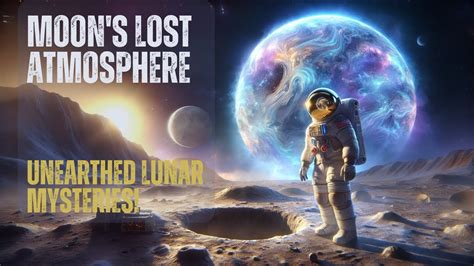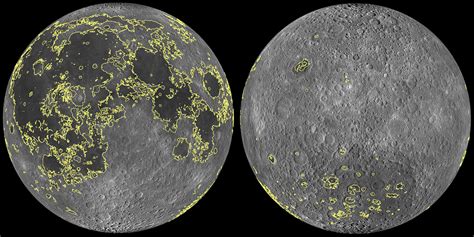Within the vast expanse of the night sky, where darkness merges seamlessly with twinkling stars, lies a universal yearning that has captivated humankind since its inception. It is a yearning to transcend earthly boundaries, to venture beyond the known, and to explore the mystical wonders that lay beyond our reach. This insatiable curiosity, deeply ingrained within our collective consciousness, has inspired generations to fix their gaze upwards, to dream of the infinite possibilities that await us in the uncharted territories of the cosmos.
Amidst these fervent aspirations, the moon has always held a special place in the hearts and minds of humans. It serves as a symbol of enlightenment, transformation, and the pursuit of knowledge. Revered in various cultures and mythologies, this celestial body has fueled a multitude of imaginations, prompting daring individuals to embark on daring quests to grasp its elusive essence.
Unbeknownst to most, the moon's enigmatic allure extends far beyond its surface appearance. Beyond the boundaries of conventional perception lies a hidden world, waiting to be unraveled. It is a world that thrives in the shadows, where secrets are whispered and forgotten wonders lay dormant.
As we embark on this journey of discovery, our desire to grasp the ungraspable and illuminate the unilluminated reflects an innate human longing to expand our horizons, to dive headfirst into the depths of the unknown. By peeling back the layers of mystery that shroud the moon and the unseen world surrounding it, we unlock not only the secrets of the cosmos, but also the secrets within ourselves.
Delving into the Enigmas of Lunar Geology

Embarking on a journey through the enigmatic realm of lunar geology allows us to dive deep into the secrets hidden beneath the moon's surface. By unraveling the mysteries of this celestial body's geological formations, we gain a profound understanding of the lunar landscape and its historic significance. This exploration enables us to grasp the intricate processes that have shaped the moon over time, shedding light on its origins and offering insights into the broader realm of planetary geology.
The Pursuit of Water on the Lunar Surface
As humans strive to explore and unravel the mysteries of celestial bodies, one significant aspect that has captured the attention of scientists and space enthusiasts alike is the quest for water on the moon. This pursuit explores the existence, availability, and potential implications of lunar water, unveiling a captivating facet of our closest celestial neighbor.
Water, an essential component for sustaining life as we know it, has long been a subject of exploration and scientific inquiry both on Earth and in space. On Earth, water is abundant, flowing through rivers, lakes, and oceans. However, its presence on the Moon, an airless and seemingly desolate environment, has challenged conventional beliefs and opened up new avenues for scientific investigation.
- 1. A Shift in Understanding: The discovery of water on the moon shattered previous assumptions and demanded a reevaluation of lunar research. While earlier missions hinted at the existence of water, it is now known that it exists in various forms, such as ice in permanently shadowed regions and molecules embedded in the lunar regolith.
- 2. Uncovering the Origins: Scientists have been working diligently to decipher the origin of lunar water. Possible sources include comets, solar wind, and internal processes within the Moon itself. By studying the isotopic compositions and molecular signatures of the discovered water, researchers hope to trace its origins and understand its significance in the broader context of the solar system.
- 3. Potential Applications: The presence of water on the moon holds immense potential for future space exploration. It can serve as a vital resource for sustaining human life during extended lunar stays and act as a catalyst for deep space missions. Additionally, water can be broken down into hydrogen and oxygen, providing valuable propellant for further space travel.
- 4. Technical Challenges: Extracting and utilizing lunar water come with a unique set of technical challenges. The extreme conditions, such as the moon's low gravity and temperature fluctuations, necessitate innovative engineering solutions. Researchers are actively exploring methods to mine and harness this resource, optimizing spacecraft designs and developing technologies to process and store lunar water effectively.
- 5. Collaborative International Efforts: The quest for water on the moon has prompted collaborative efforts between space agencies worldwide. International missions, like NASA's Artemis program and the ESA's Lunar Gateway project, aim to uncover more insights into the presence and properties of lunar water. These joint endeavors foster scientific cooperation and facilitate the sharing of knowledge and technological advancements.
In conclusion, the pursuit of water on the moon represents a remarkable scientific endeavor that has revolutionized our understanding of lunar geology and the potential for sustaining life beyond Earth. By unraveling the mysteries hidden within the lunar environment, scientists are paving the way for future space exploration and expanding the boundaries of human knowledge.
Unearthing the Lunar Atmosphere: Unexpected Revelations

The enigmatic realm encompassing the moon has been the subject of intense curiosity and speculation throughout human history. Delving into the mysteries shrouding the lunar atmosphere, scientists have embarked on a journey to unravel its hidden secrets. Through meticulous exploration and groundbreaking research, a multitude of surprising discoveries have emerged, challenging our preconceived notions and opening new avenues of understanding.
First and foremost, one of the most intriguing revelations pertains to the composition of the lunar atmosphere. Contrary to popular belief, this ethereal realm is not devoid of matter as previously hypothesized. Rather, it exhibits a nuanced interplay of gases and particles that have evaded our detection until recent technological advancements. These newfound elements have sparked a wave of excitement among scientists as they strive to unravel the complex interdependencies and dynamics characterizing the lunar atmosphere.
Furthermore, the exploration of the lunar atmosphere has uncovered perplexing phenomena that defy conventional wisdom. Contrasting with the Earth's atmosphere, the lunar counterpart appears to be noticeably patchy and sporadic in its distribution. These unexpected patterns have sparked a wealth of speculation and ongoing investigations into the underlying mechanisms responsible for this peculiar behavior. The potential involvement of lunar regolith, electromagnetic interactions, or even extraterrestrial influences has ignited fervent scientific debates within the field.
Additionally, the presence of volatile compounds within the lunar atmosphere has stunned researchers and challenged established theories. The detection of rare gases and molecules, interwoven within the lunar exosphere, has fueled discussions surrounding their origins and implications. The existence of these volatile compounds not only provides valuable insights into the moon's geological history but also prompts reconsideration of its potential for supporting future human exploration and colonization endeavors.
Unveiling the lunar atmosphere has undoubtedly exposed a hitherto unseen realm teeming with surprises and mysteries waiting to be deciphered. As scientists delve deeper into its depths, armed with cutting-edge technology and unwavering curiosity, the stage is set for undiscovered revelations that may reshape our understanding of the moon and the broader universe.
Exploring the Enigma: The Mysteries Beneath the Moon's Surface
Delving into the enigmatic realm of the Moon's magnetic field offers a captivating opportunity to unravel the secrets of its origin. By meticulously investigating the characteristics and behavior of this magnetic field, scientists gain valuable insights that aid in deciphering the Moon's intricate history.
Through a series of intricate experiments and advanced technologies, researchers have been able to collect a wealth of data that sheds light on the intriguing properties of the Moon's magnetic field. The presence of this magnetic force, although significantly weaker than Earth's, poses thought-provoking questions about the celestial body's formation and evolution.
- Magnetic Imprinting: One fascinating aspect that scientists have uncovered is the "fossilized" nature of the Moon's magnetic field. Evidence suggests that its magnetic properties were imprinted early in its formation, capturing clues about the conditions present at the time.
- Origins and Decay: Probing the Moon's magnetic field provides important clues about its origin. By studying its strength and changes over time, researchers aim to unravel the mechanisms behind its formation and potential decay.
- Interplay with Solar Wind: The Moon's magnetic field interacts with the solar wind, a stream of charged particles emanating from the Sun. Investigating this interaction helps researchers understand how the Moon's environment is shaped and how it influences the surface and surrounding space.
- Mission Insights: Through various lunar missions, such as Apollo and recent robotic explorations, scientists have collected valuable data that has further deepened our understanding of the Moon's magnetic field. These mission insights provide crucial information for formulating comprehensive models and theories.
By peering into the enigmatic world of the Moon's magnetic field, researchers are gradually piecing together the intriguing puzzle of its origin. Each new discovery and analysis brings us closer to unraveling the mysteries that lie beneath the Moon's surface, revealing a wealth of knowledge about our celestial neighbor.
Lunar Volcanism: Ancient Eruptions and their Significance

In the pursuit of uncovering the hidden mysteries of the celestial body that orbits our planet, there lies a captivating aspect of the lunar landscape that demands attention: lunar volcanism. This section delves into the intriguing realm of ancient volcanic eruptions on the Moon and their profound importance in unraveling the secrets of our lunar companion.
The Moon, our enigmatic satellite, offers a multitude of geological wonders, and lunar volcanism stands as a testament to the profound forces at work in shaping its surface over billions of years. Without descending into the specifics just yet, the significance of these ancient eruptions lies in their potential to provide invaluable insights into the lunar history, geology, and even our understanding of planetary bodies beyond our own.
However, before we can fully comprehend the significance of lunar volcanism, it is imperative to grasp the fundamental concepts and characteristics of these ancient eruptions. From lava flows to volcanic craters and domes, the Moon's volcanic features come in various forms, each holding its own story etched in the lunar bedrock. By studying the composition of volcanic rocks and the morphological characteristics of different volcanic features, scientists can decipher the nature, timing, and scale of lunar eruptions. These insights shed light on the Moon's volcanic activity's intensity and duration, offering invaluable clues about the Moon's internal processes and its evolution through time. |
Understanding lunar volcanism permits us to create a timeline of volcanic events, thus unraveling the geologic history of the Moon. By analyzing the ages of volcanic rock samples collected during various lunar missions, scientists have mapped out a chronology of eruption episodes, allowing us to grasp the lunar landscape's transformation.
Moreover, lunar volcanism also provides a unique window into the formation and dynamics of volcanic systems on other planetary bodies. Comparing lunar volcanic features to those found on Earth, Mars, and other moons within our own solar system enables scientists to draw parallels and uncover the underlying principles that govern volcanic activity across the cosmos.
In conclusion, exploring the realm of lunar volcanism not only enriches our understanding of the Moon's past, but it also expands our knowledge of planetary sciences as a whole. By delving into the ancient eruptions and deciphering their stories, scientists are granted a glimpse into the Universe's inner workings, painting a vivid picture of the unseen forces that shape worlds beyond our own.
Delving into the Origin of Lunar Dust: Celestial Clues to the History of our Solar System
Exploring the enigmatic nature of lunar dust provides a unique opportunity to unravel the mysteries shrouding the formation and evolution of our solar system. By delving into the origins of this celestial residue, scientists aim to uncover cosmic clues that shed light on the cosmic processes that shaped the Earth and its neighboring celestial bodies.
Lunar dust, a captivating substance that veils the surface of the moon, holds immense potential in unraveling the intricate tapestry of our solar system's history. This elusive material, composed of minuscule particles that have journeyed through space, carries with it a wealth of information waiting to be deciphered.
Through meticulous analysis and examination, scientists strive to unravel the secrets locked within these microscopic fragments, seeking answers to questions that have eluded us for centuries. By scrutinizing the chemical composition, mineralogy, and age of lunar dust particles, researchers hope to gain insights into the history of our solar system, including the cataclysmic events that shaped our cosmic neighborhood.
By connecting the dots between lunar dust and other celestial bodies, scientists aim to reconstruct the evolutionary timeline of the solar system. The unique composition and characteristics of lunar dust serve as a repository of information from distant cosmic regions, enabling us to glimpse the birth and transformation of planets and satellites over billions of years.
Moreover, the study of lunar dust provides invaluable insights into the conditions prevalent during the formation of our solar system. By examining the isotopic composition of these particles, researchers can discern the origins of lunar dust, linking them to specific cosmic events such as supernova explosions or even the birth of stars.
Through relentless pursuit, scientists unravel the secrets of lunar dust, unearthing its cosmic worth as a vital time capsule of our celestial past. As we delve deeper into the enigmatic nature of these particles, we inch closer to uncovering the grand story of our solar system's genesis and unraveling the mysteries of the cosmos.
FAQ
What is the article "Dreams of Reaching the Moon: Unveiling the Unseen World" about?
The article "Dreams of Reaching the Moon: Unveiling the Unseen World" discusses the fascination humans have with the moon and the exploration of the unknown realms that lie beyond it.
Why are humans so fascinated with the moon?
Humans are fascinated with the moon due to its mysterious nature, its influence on tides, and its connection to various cultural and religious beliefs throughout history.
What are some of the unseen worlds beyond the moon that the article mentions?
The article mentions the possibility of uncovering hidden celestial bodies, undiscovered planetary systems, and even encountering extraterrestrial life in the vast expanse of space.
How does the article explore the topic of reaching the moon?
The article delves into the historical progress of moon exploration, from the Apollo missions to current and future plans of space agencies and private companies aiming to return humans to the moon and establish a sustained presence there.




